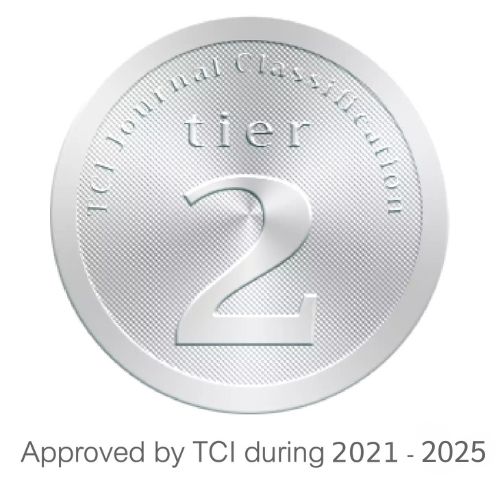ผลการจัดการสมรรถนะการเรียนรู้ของผู้เรียนด้านวิทยาศาสตร์และ เทคโนโลยี ระดับปริญญาตรี
Results of Learning Performance Management of Science and Technology Undergraduates
Keywords:
ผลการจัดการสมรรถนะการเรียนรู้, ผู้เรียนด้านวิทยาศาสตร์และเทคโนโลยี, ระดับปริญญาตรีAbstract
การวิจัยครั้งนี้มีวัตถุประสงค์เพื่อศึกษาการจัดการสมรรถนะการเรียนรู้ของผู้เรียนด้านวิทยาศาสตร์ และเทคโนโลยีระดับปริญญาตรีตามกรอบมาตรฐานการเรียนรู้ที่พึงประสงค์ในศตวรรษที่21 จำ นวน 5 ด้าน คือ 1) ด้านคุณธรรม จริยธรรม 2) ด้านความรู้3) ด้านทักษะทางปัญญา 4) ด้านทักษะความ สัมพันธ์ระหว่างบุคคลและความรับผิดชอบ และ 5) ด้านทักษะการวิเคราะห์เชิงตัวเลข การสื่อสาร และการใช้เทคโนโลยีสารสนเทศ กลุ่มตัวอย่าง ได้แก่ ผู้เรียนระดับปริญญาตรีชั้นปีที่ 4 ของวิทยาลัย เทคโนโลยีอุตสาหกรรม มหาวิทยาลัยเทคโนโลยีพระจอมเกล้าพระนครเหนือ ปีการศึกษา 2559 จำ นวน 358 คน ใช้วิธีสุ่มแบบแบ่งชั้นภูมิ(Stratified Random Sampling) เครื่องมือที่ใช้ในการวิจัย เป็นแบบสอบถามสมรรถนะการเรียนรู้จำ นวน 1 ฉบับ วิเคราะห์ข้อมูลโดยการหาค่าเฉลี่ย ส่วนเบี่ยง เบนมาตรฐาน การทดสอบค่าทีแบบอิสระ (t-test Independent) และการวิเคราะห์ความแปรปรวน ทางเดียว (One-Way ANOVA) ผลการวิจัยสรุปได้ดังนี้1)การจัดการสมรรถนะการเรียนรู้ของผู้เรียนภาพรวม อยู่ในระดับมาก โดยผลการจัดการสมรรถนะการเรียนรู้ของผู้เรียน รายด้าน อยู่ในระดับมากทั้ง 5ด้าน 2)การเปรียบเทียบ การจัดการสมรรถนะการเรียนรู้ของผู้เรียนระหว่างเพศชายและเพศหญิง พบว่า ไม่แตกต่างกัน อย่าง มีนัยสำคัญทางสถิติที่ระดับ .05References
Chetniphat Boonyasawat. (2011). The Characteristics of Desirable Graduates According to National Higher Education Qualification Standards in the Food and Nutrition Program. Bangkok: Rajamangala University of Technology Phra Nakhon.
Chickering, A. W. & Reisser, L. (1993). Education and Identity. San Francisco. CA: Jossey-Bass.Educational Quality Assurance Center, King Mongkut’s University of Technology North Bangkok. (2019).
Education Quality Assurance News No. 427 (First Half, March 2019). Bangkok: King Mongkut’s University of Technology North Bangkok.
Likert, Resis. (1967). The Method of Constructing and Attitude Scale. In Fishbeic, M (ed.),Attitude Theory and Measurement. pp. 90-95. New York: Wiley & Son.
McClelland, D.C. (1973). Testing for Competence Rather than for Intelligence. AmericanPsychologist, 28: 1-14.
Office of the Higher Education Commission, Ministry of Education. (2011). Announcementof the Higher Education Commission, Topic of Guidelines for Compliance with the National Higher Education Qualifications Framework (Issue 2).Bangkok: Office of the Higher Education Commission.
Office of Science Policy Committee National Technology and Innovation. (2019). Strategy8: Development of Science, Technology, Research and Innovation. Retrievedon March, 21, 2019, from www.most.go.th/126-about-general/mission-and-responsibilities/1513-Sit?=Component&print=1
Rangsan Yomya (2018). The Study of Self-Learning Behavior of Mahasarakham UniversityStudents. Journal of Education Mahasarakrm University, 12(3): 309-317.
Sukanya Rasmithamchoti. (2004). Competency: Undeniable Administrative Tools. Productivity. 9(November-December): 44-48.
Suwit Mesinaree. (2016). Concepts of Thailand 4.0. Retrieved on January 11, 2019, from planning2.mju.ac.th/wtms_documentDownload.asp?MjY4MTE
Thanin Sinjaru (2008). Statistical Research and Analysis with SPSS. 9th ed. Bangkok: Business R & D.
Waraporn Aewsakun. (2012). Teaching TQF Era Part 3: Teaching Numerical Analysis, Communication, Technology Use. Retrieved on January 11, 2019 from www.ubu.ac.th/web/files_up/04f-2012061814221544.docx.
Wichan Phanich (2012). Production of Graduates in the 21st Century. Suranaree J.Soc. Sci, 6(2): 130-152.








